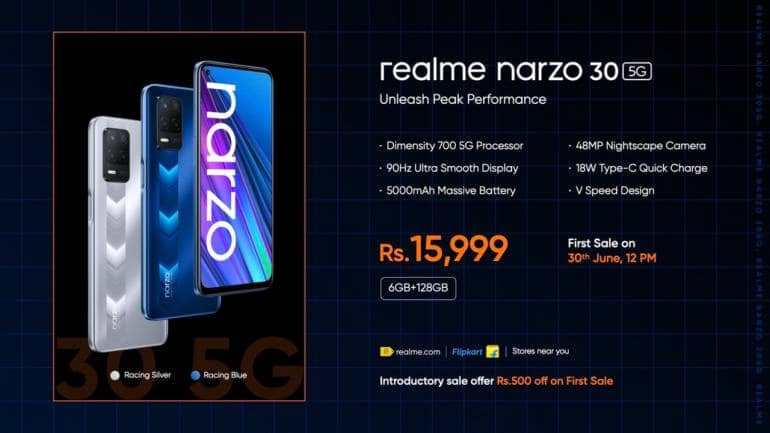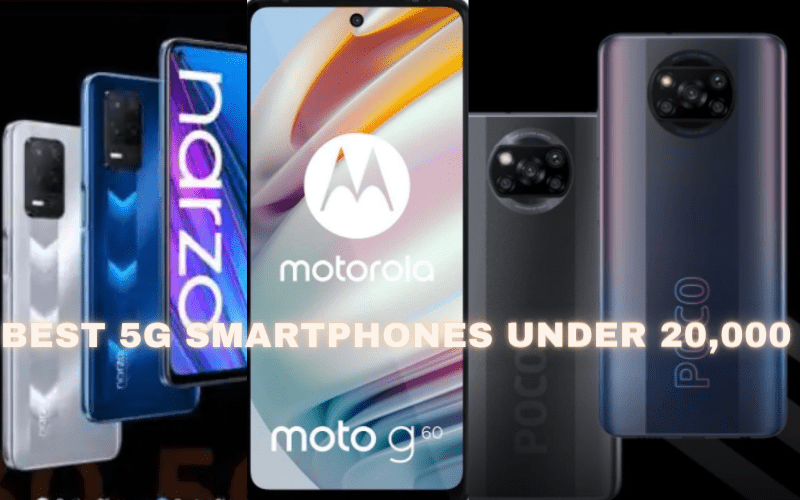Here’s List Of Best 5G Smartphones Under 20,000
New Delhi: If you have a budget of Rs. 20,000 and want to invest in a 5G smartphone, this list is for you. Each smartphone on this list has received an overall rating of 8 or above from users, which means each device here will deliver on all fronts, from battery life, camera, design, display, performance, and software to value for money.
Realme Narzo 30 5G

Realme’s Narzo 30 5G offers some great hardware but cuts corners in some areas to make it all happen. The smartphone uses a vibrant and sharp full-HD+ display with a 90Hz refresh rate. The display also offers a maximum 180Hz touch sampling rate, which combined with the MediaTek Dimensity 700 processor, makes for a decent gaming smartphone. Realme UI 2.0 runs smoothly with everyday use but comes with several pre-loaded third-party apps. The Narzo 30 5G, just like the Narzo 30 does not offer an ultra-wide-angle camera, which you did get with the previous Narzo 20 series. Out of the three rear cameras, only two are accessible to the user, as the 2-megapixel monochrome camera is only activated when using the Portrait mode. The performance of these cameras is also quite average. Video recording is limited to 1080p @30fps, which is a bit disappointing, given that the more affordable Narzo 30 offers better options. Battery life is quite good, but charging this phone using the bundled 18W charger takes over two hours.
Motorola Moto G60

The Moto G60 is the first Motorola smartphone with a 108-megapixel camera and is priced quite aggressively. The Moto G60 is a big and bulky phone measuring 9.8mm in thickness and has a weight of 225g. This makes single-handed use a little tough. It has a big 6.8-inch LCD display with a 120Hz refresh rate. It has a hole punch at the top that houses the 32-megapixel selfie camera.
Moto G60 is powered by the tried and tested Qualcomm Snapdragon 732G processor and delivers good performance. It has only one variant in India offering 6GB of RAM and 128GB of storage. Storage is further expandable using the hybrid SIM slot. The Moto G60 houses a 6,000mAh battery which makes it bulky. The battery offers a day and a half worth of battery life but charging time is long as the phone only gets a 20W charger in the box.
The Moto G60 has a triple camera setup at the back but does the job of four cameras. It has a 108-megapixel primary camera, an 8-megapixel ultra-wide-angle camera that also clicks macros, and a depth sensor. Photos clicked from the Moto G60 were average and not as sharp as some of the other competition in daylight. The ultra-wide-angle photos are upscaled to 12-megapixels and had some distortion.
Lowlight photos were also average as the phone failed to get the colour tone right. Night mode does not return a brighter image but fixes the colour tone issue. Motorola ships the Moto G60 with Android 11 with only the Facebook app pre-installed. This is a big plus considering most of the completion has spammy bloatware preinstalled.
iQOO Z3

While the iQoo Z3 does not follow in the footsteps of the gamer-centric iQoo 3, it succeeds as an affordable smartphone that not only looks good, but also offers a good processor considering its price. The iQoo Z3 uses the Qualcomm Snapdragon 768G, a mid-range SoC that surprisingly makes it to this affordable smartphone. While the performance of this new SoC is noticeable, it’s not a gigantic leap over the competition. This is where the other interesting hardware bits of the iQoo Z3 come in. There’s a triple-camera setup that performs well in daylight but suffers in low light. The 4,400mAh battery charges to 100 percent in just 60 minutes using the included 55W charging adapter. The 120Hz LCD panel is useful for gamers thanks to its 180Hz touch sampling rate. Factor in that attractive price tag, and iQoo seems to have a solid contender.
Realme 8 Pro

Realme 8 Pro is the successor to the Realme 7 Pro and gets a bold design. It is slimmer than its predecessor and comes in flashy colours. The main change on the Realme 8 Pro is the quad-camera setup at the back which houses a 108-megapixel primary camera. The phone is light and easy to hold.
It sports a 6.4-inch AMOLED display with a hole punch for the selfie camera in the top left corner. The display has full-HD+ resolution and an in-display fingerprint scanner. It is also powered by the Qualcomm Snapdragon 720G processor, with 6GB or 8GB of LPDDR4X RAM and 128GB of UFS 2.1 storage. You get a 4,500mAh battery that is capable of fast charging at 50W.
The camera performance is a hit or miss with the Realme 8 Pro. Daylight photos were average and did not have as much detail. The phone does a good job with portrait shots and the macros too were sharp but limited to 2-megapixels in resolution. Camera performance in low light was decent with better details in night mode.
Realme 8 Pro managed to deliver good battery life and lasted for 26 hours and 14 minutes in our HD video loop test. The 50W bundled charger is quick to charge the phone up getting it to 75 percent in 30 minutes.
Poco X3 Pro

The main selling point of the Poco X3 Pro is its Qualcomm Snapdragon 860 SoC, which is a slightly faster version of the erstwhile flagship Snapdragon 855. This makes the X3 Pro perform very well in benchmarks and even in real-world tasks, including high-end games. You should have more than enough power to get through all your day-to-day activities. Battery life is also quite good, but the large battery makes this phone heavy and bulky. You don’t get 5G which might make this phone seem to lag behind some of its competitors. The full-HD+ screen has a 120Hz refresh rate. Its quality is serviceable but not as good as some others at this price level. Similarly, the cameras deliver acceptable performance but photo and video quality aren’t strong points of the Poco X3 Pro. With its eye-catching design and prominent camera bump, the Poco X3 Pro will appeal to young buyers who want performance above all else.


Comments are closed.